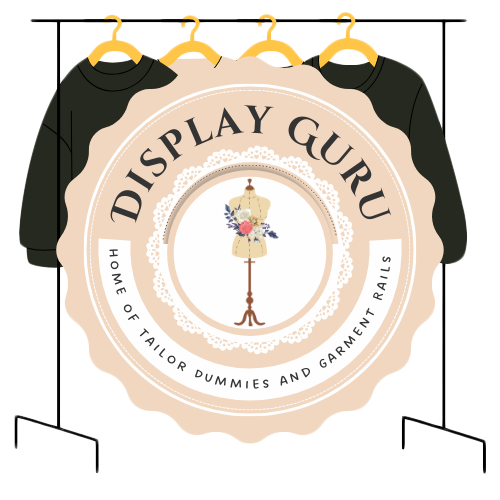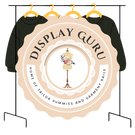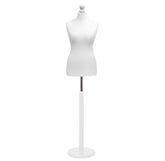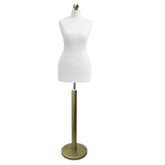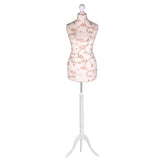Visual Merchandising Guidelines: Boost Sales & Engage Customers
Why Visual Merchandising Guidelines Matter More Than Ever
In a crowded retail market, it’s a huge mistake to think of your store’s appearance as simple decoration. Instead, imagine it as your most effective salesperson—one that works around the clock, telling your brand’s story and shaping what customers decide to buy. Strategic visual merchandising guidelines are not just about making a shop look nice; they are the blueprint for turning casual browsers into loyal shoppers.
The retailers who are thriving today grasp this concept fully. They know that every display, every spotlight, and every product placement is a calculated move designed to influence customer behaviour. This isn't just a gut feeling; the results are clear and measurable.
Research shows that well-designed retail displays can increase sales by up to 10% and add a remarkable 40% to the perceived value of a product. These numbers reveal a powerful truth: what your customers see has a direct impact on what they’re prepared to spend. It proves that thoughtful visual merchandising is a direct investment in your business’s financial health.
From Browsing to Buying
The difference between a store where people look and a store where they buy often comes down to the clarity of its visual strategy. A shop that just stacks products on shelves without any sort of narrative can feel confusing. This often causes potential buyers to walk out empty-handed. In contrast, a retailer with clear visual merchandising guidelines creates an intentional journey for every visitor.
This journey achieves several vital goals:
- Tells a Cohesive Story: Every element, from the window display to the checkout counter, works together to reinforce the brand's identity and promise.
- Directs Customer Flow: Carefully planned layouts and focal points guide shoppers through the store, ensuring they see key products along the way.
- Highlights Product Value: Smart use of lighting, colour palettes, and product groupings can make items seem more desirable and worth their price tag.
The Silent Conversation
Ultimately, your visual merchandising is having a constant, silent conversation with every person who enters your store. It answers their unspoken questions: "Is this brand for me?", "What’s new and exciting?", and "Why should I buy this here instead of somewhere else?".
When your displays offer convincing answers to these questions, you create an environment that doesn't just store stock—it actively sells it. This is why setting and following clear visual merchandising guidelines is no longer a 'nice-to-have'. For modern retail, it’s essential for survival and growth.
The Psychology Behind Displays That Actually Sell
Going beyond merely arranging products, truly effective visual merchandising connects directly with customer psychology. Imagine your shop not as a building filled with items, but as a silent conversation with every person who walks through the door. Each choice of colour, every angle of light, and the way products are grouped together acts as a subtle prompt, shaping a shopper's mood and guiding their path to a purchase. It's the art of turning a brief glance into a committed sale.
This process starts by tapping into a basic human instinct: our eyes are automatically drawn to points of interest. By creating a strong focal point within a display—a single, central item that commands attention—you give customers a clear place to begin their visual journey. This is where you can be clever with lighting and colour. A simple spotlight on a new product or a splash of bold colour behind a key item can instantly transform a busy shelf into a captivating story. Studies show that up to 90% of purchasing decisions can be influenced by visual appearance alone, highlighting just how important that first impression is.
Orchestrating the Customer's Gaze
Once you have their attention, the next step is to direct it. This is done through visual hierarchy, which is essentially creating a roadmap for the shopper's eyes to follow. The best retailers arrange products to lead the eye from the main focal point towards secondary and tertiary items. A powerful technique to achieve this is the Rule of Three.
Grouping products in odd numbers, particularly in threes, is more visually pleasing and easier for the human brain to process than even-numbered arrangements. It creates a feeling of balance and purpose. For example, a display could feature:
- A standout "hero" product (the focal point).
- A complementary secondary item.
- A smaller, related accessory.
This combination feels complete without being cluttered, encouraging shoppers to see the items as a cohesive set. You can learn more about how different structures support these psychological principles by exploring various types of retail display stands and their specific uses.
To help you understand how these principles work together, the table below breaks down their application and impact.
Core Visual Merchandising Principles and Their Impact
A comparison of key visual merchandising principles showing their specific applications and expected outcomes.
| Principle | Application | Customer Impact | Sales Benefit |
|---|---|---|---|
| Focal Point | Using a spotlight, bold colour, or a unique prop to highlight a single product in a display. | Immediately draws the eye, providing a clear starting point for engagement and reducing visual clutter. | Increases visibility for new arrivals or high-margin items, leading to faster sales. |
| Visual Hierarchy | Arranging products to guide the eye from the focal point to supporting items, often using size and placement. | Creates a logical and intuitive shopping path, making it easy for customers to discover related products. | Encourages cross-selling and upselling by naturally introducing complementary items. |
| Rule of Three | Grouping items in threes (e.g., a mannequin with a top, trousers, and a bag). | The grouping feels balanced and intentional, making the overall display more memorable and appealing. | Boosts bundle sales and increases the perceived value of the entire set. |
| Colour Psychology | Using specific colours to evoke emotions (e.g., red for sales, blue for trust, green for eco-friendliness). | Subtly influences mood and perception, making the shopping environment more inviting or urgent. | Can drive impulse buys during promotions and build long-term brand affinity. |
By mastering these fundamental principles, your visual merchandising strategy becomes a powerful tool for driving sales. It's not just about making things look good; it's about making them sell.
This infographic shows how these psychological principles translate into tangible business benefits, connecting sales growth with engagement and time spent in-store.
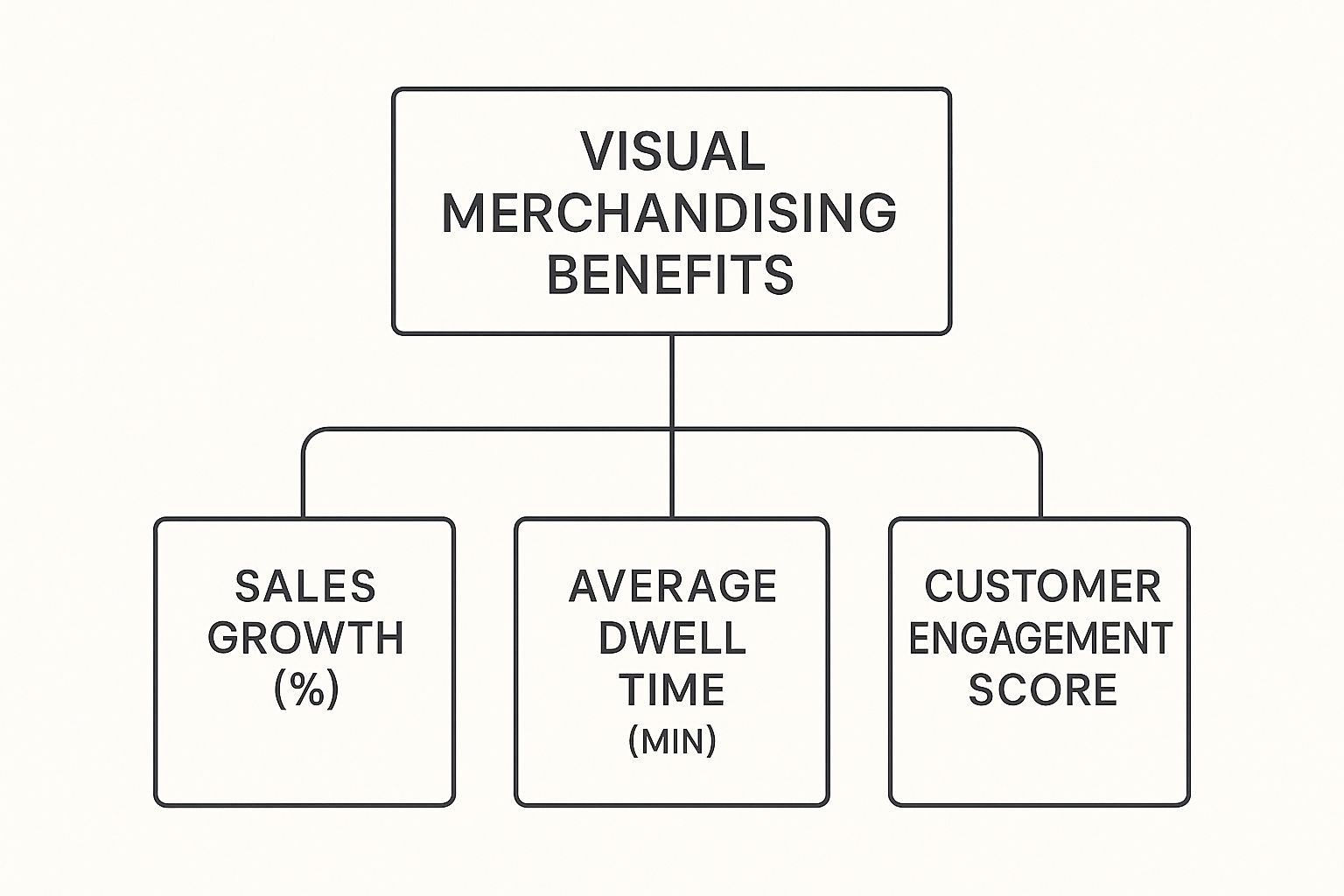 The diagram clearly illustrates that when customer engagement and dwell time increase through smart visual tactics, a corresponding rise in sales is the natural outcome. By mastering these psychological triggers, your visual merchandising guidelines become a powerful tool for converting interest into revenue, proving that how you sell is just as important as what you sell.
The diagram clearly illustrates that when customer engagement and dwell time increase through smart visual tactics, a corresponding rise in sales is the natural outcome. By mastering these psychological triggers, your visual merchandising guidelines become a powerful tool for converting interest into revenue, proving that how you sell is just as important as what you sell.
Creating Customer Flow That Maximises Every Square Foot
A store's layout is much more than just an arrangement of furniture and fixtures; it's a carefully choreographed dance floor, designed to guide customers on a journey of discovery. Your visual merchandising guidelines must define this journey, transforming a simple shopping trip into a natural pathway that leads toward a purchase. This process begins the moment a customer walks through your door.
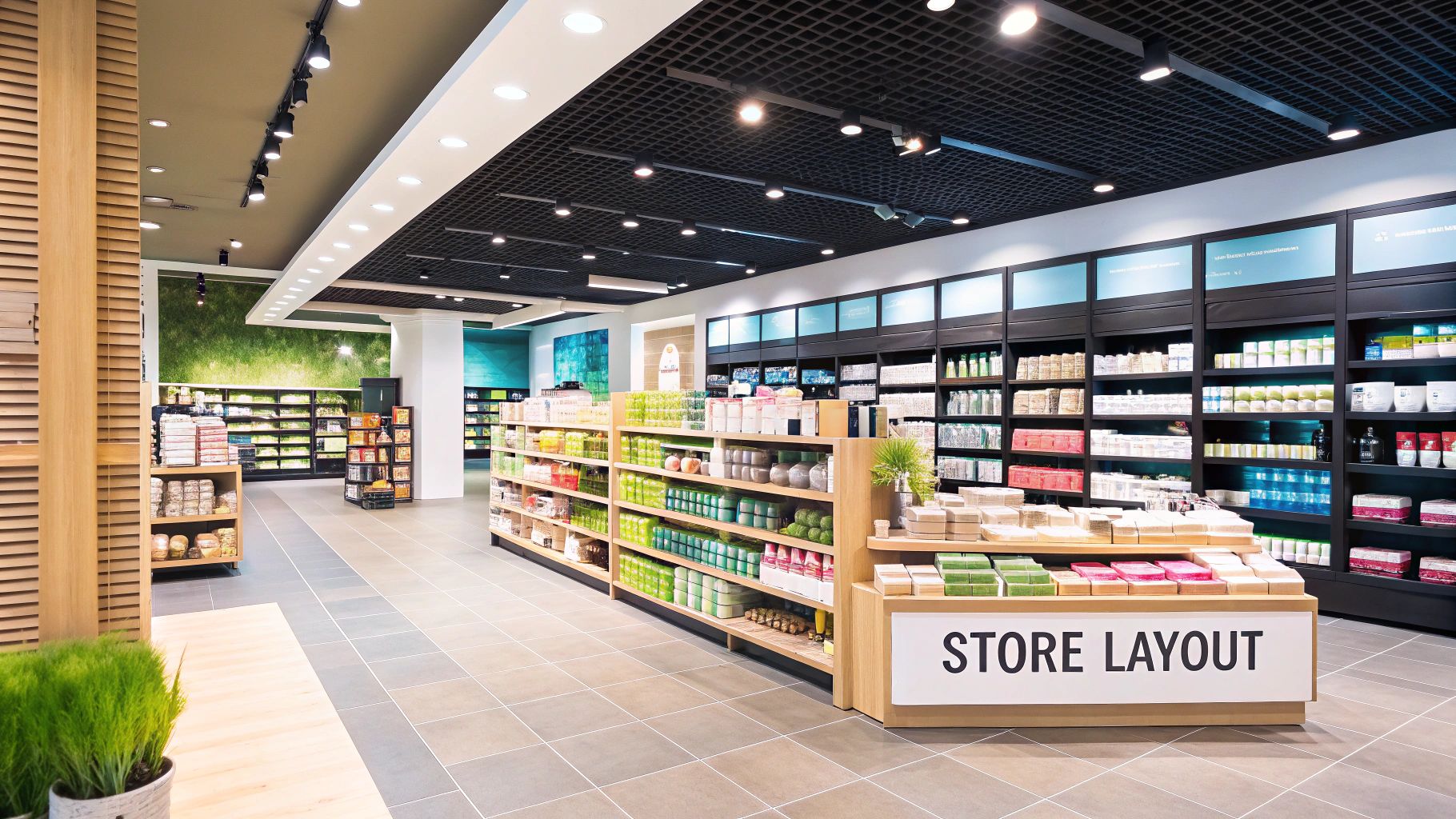
The first area they enter is often called the "decompression zone." Think of it as an entryway that allows shoppers to transition from the busy outside world to the calmer environment of your store. Keeping this space open and uncluttered is crucial, as it sets a welcoming tone for their entire visit. From here, the most effective layouts guide shoppers along a specific route—often favouring a right-hand turn, as research shows most people naturally drift this way. By creating a circular path, you can expose them to the maximum number of products without them feeling lost or overwhelmed.
Designing Pathways and Pauses
The secret to a great layout is creating intentional stopping points along this main path. Think of these as "speed bumps" for shoppers. These aren't obstacles, but rather engaging displays that encourage pause and interaction. Placing a well-styled mannequin or a "hero" product display at the end of an aisle draws the eye and pulls customers deeper into the store. In an apparel shop, a perfectly put-together outfit can be incredibly persuasive. For tips on achieving this, our guide on using an adjustable mannequin for sewing can help you create flawless presentations.
This approach leads to a few fundamental layout strategies:
- Grid Layout: Common in supermarkets and pharmacies, this layout uses long, parallel aisles to maximise product display space. It’s highly efficient but can feel less inspiring for browsing.
- Loop Layout: This design creates a clear, defined path that takes customers past most of your stock, a style famously used by IKEA. It offers excellent product exposure.
- Free-Flow Layout: More often found in boutiques, this layout uses fixtures and displays to create a more relaxed, meandering path. It encourages leisurely browsing and a sense of discovery.
Ultimately, your goal is to make every square foot work for you by understanding how people move through a space. By engineering a flow that feels both intuitive and interesting, you turn your floor plan into one of your most powerful sales tools.
Adapting Your Displays For Today's Retail Reality
While the core principles of great visual merchandising haven't changed, the world they exist in certainly has. The most successful retailers aren't just keeping up with new shopping habits; they're getting ahead of them. They do this by mixing classic display techniques with the expectations of the modern, digitally-savvy shopper. This means your shop floor needs to be more than just shoppable—it needs to be shareable and feel connected to your customers' online lives.
The trick is to weave in technology that genuinely adds value without overpowering the products. Think of digital touches as accent lighting for your displays, not the main attraction. Instead of expensive, high-maintenance interactive screens that customers often ignore, smart retailers are using more subtle and practical digital tools.
Bridging the Physical and Digital Divide
Creating a smooth journey between your online shop and your physical store is essential. With online sales expected to account for 27.2% of all retail sales by May 2025, it's obvious that your customers are very comfortable in a digital environment. Your in-store displays should embrace this reality, not fight it. You can explore official retail sales data to see how these trends are shaping the industry and learn more about recent e-commerce statistics from the ONS.
Here are a few clever ways to connect the two worlds:
- QR Codes: These are simple, effective, and something everyone now understands how to use. A small QR code on a display can instantly take a shopper to product reviews, a 'how-to-style-it' guide, or your brand's Instagram feed featuring the item in real-world settings.
- 'As Seen Online' Signage: Highlighting your online bestsellers in-store creates a comforting sense of familiarity. It acts as a social proof, telling shoppers, "Hey, lots of people already love this."
- Instagrammable Moments: This doesn't mean you need to build a massive, elaborate selfie wall. It can be as simple as a beautifully arranged corner with great lighting or a uniquely artful display. These moments encourage your customers to create their own content, effectively turning them into your best marketers.
Technology That Serves, Not Sells
The aim of using technology in-store should be to answer questions and help customers feel more connected to your products. Imagine a tablet placed near a complex item, silently playing a short video that demonstrates how it works. This is far more engaging than a static sign. The product remains the hero, and the technology plays the part of a helpful assistant.
By carefully adding these elements, you can adapt your visual merchandising to meet modern expectations. You'll create a more engaging, unified brand experience that helps drive sales, both in your physical shop and online.
Seasonal Strategies That Drive Sales Year-Round
Effective visual merchandising is about more than just reacting to major holidays like Christmas or Easter. It involves proactively tapping into your customers' mindset all year round. The most successful retailers plan their displays around buying moods and life events, not just calendar dates. This approach helps you run timely, relevant promotions that drive sales without the need for a costly, exhausting store overhaul every month.

Think of your seasonal strategy as a continuous story with different chapters. Instead of sudden, jarring changes, aim for smooth transitions. For instance, moving from winter to spring doesn't have to happen overnight. It can start with subtle shifts in your colour palette—introducing lighter tones—and then gradually changing the products on your key displays. This method keeps your store feeling fresh and avoids the odd sight of heavy winter coats one day and summer dresses the next.
Managing Inventory Through Timely Displays
Seasonal shifts present a perfect opportunity to manage your stock levels. As a new season approaches, your visual merchandising guidelines should focus on clearing out old inventory to make space for new arrivals. By grouping end-of-season items in a clearly marked, high-traffic area, you create a sense of urgency. A well-placed sign indicating "Last Chance" or "Final Reductions" can be incredibly effective.
This strategic placement ensures older stock gets maximum visibility before it becomes irrelevant, protecting your profit margins. At the same time, you can start teasing new collections. Dedicate a small, high-impact area near the entrance to a "New Season Preview" display. This builds anticipation and gives loyal customers a reason to return. The key is balance; you want to sell through the old without devaluing the new. You might also explore how different mannequins can support these strategies; for example, using inclusive forms like plus-size mannequins for stylish displays can help your seasonal stories resonate with a wider audience.
To help you plan, here is a breakdown of key retail periods and merchandising ideas to keep your displays relevant and engaging throughout the year.
Seasonal Visual Merchandising Calendar
Monthly breakdown of key retail periods and corresponding visual merchandising strategies
| Month | Key Events | Merchandising Focus | Display Techniques |
|---|---|---|---|
| January | New Year, "New You", Winter Sales | Health, wellness, organisation, clearance | Group sale items, use "Fresh Start" signage, minimalist displays with cool colours. |
| February | Valentine's Day, Half-Term | Gifting, love, relationships | Use red and pink palettes, heart motifs, gift set bundles, "Gifts for Him/Her" sections. |
| March | Mother's Day, Start of Spring | Gifting, renewal, spring cleaning | Introduce pastel colours, floral patterns, lightweight fabrics, gardening or cleaning themes. |
| April | Easter, Spring Bank Holidays | Family, holidays, outdoor activities | Bright, cheerful colours, Easter-themed props (eggs, bunnies), travel-size product displays. |
| May | Bank Holidays, Start of Summer | Travel, weddings, outdoor living | Create holiday shop sections, showcase occasionwear, use bright lighting and beach props. |
| June | Father's Day, Summer Solstice | Gifting, outdoor events, BBQs | Masculine colour palettes, focus on hobbies (e.g., grilling, tech), summer fashion displays. |
| July | School Holidays, Summer Sales | Travel, heatwave essentials, clearance | High-energy "Holiday Shop" displays, group clearance stock, promote fans or cooling items. |
| August | Bank Holiday, "Back to School" | Last-minute holidays, preparing for autumn | Transition displays with warmer tones, introduce "Back to School/University" sections. |
| September | Autumn Begins, Fashion Week | New season fashion, cosy living | Layered outfits on mannequins, use autumnal colours (orange, brown), soft textures. |
| October | Halloween, Half-Term | Festivities, comfort, autumn activities | Use spooky but stylish props, pumpkin motifs, promote cosy jumpers and home comforts. |
| November | Bonfire Night, Black Friday, Pre-Christmas | Gifting, party season, major promotions | Bold "Black Friday" signage, create dedicated gift zones, introduce festive sparkle and glitter. |
| December | Christmas, New Year's Eve | Ultimate gifting, celebration, luxury | Create a winter wonderland, use rich colours (red, green, gold), build extravagant window displays. |
This calendar provides a solid foundation, but remember that the most impactful strategies are often those tailored to your specific location and customer base.
The Local Rhythm Over National Trends
While national retail calendars offer a useful framework, understanding your local market's unique rhythm is far more important. A seaside town's "summer" season might start much earlier than a city-centre shop's. Pay attention to local events, school holidays, and community festivals. These are your real seasonal moments.
By aligning your visual merchandising with the local pulse, your displays will feel authentic and genuinely connected to your customers' lives. This hyper-local approach builds a stronger community connection and shows that you understand their specific needs, turning your shop into a go-to destination year-round.
Making a Big Impact With Real-World Constraints
Excellent visual merchandising guidelines don’t rely on unlimited budgets or perfectly shaped retail spaces. In fact, some of the most creative and effective displays are born from limitations. Acknowledging your constraints—whether it’s a modest budget, an awkward floor plan, or strict corporate rules—is the first step toward finding clever, high-impact solutions that truly connect with customers.
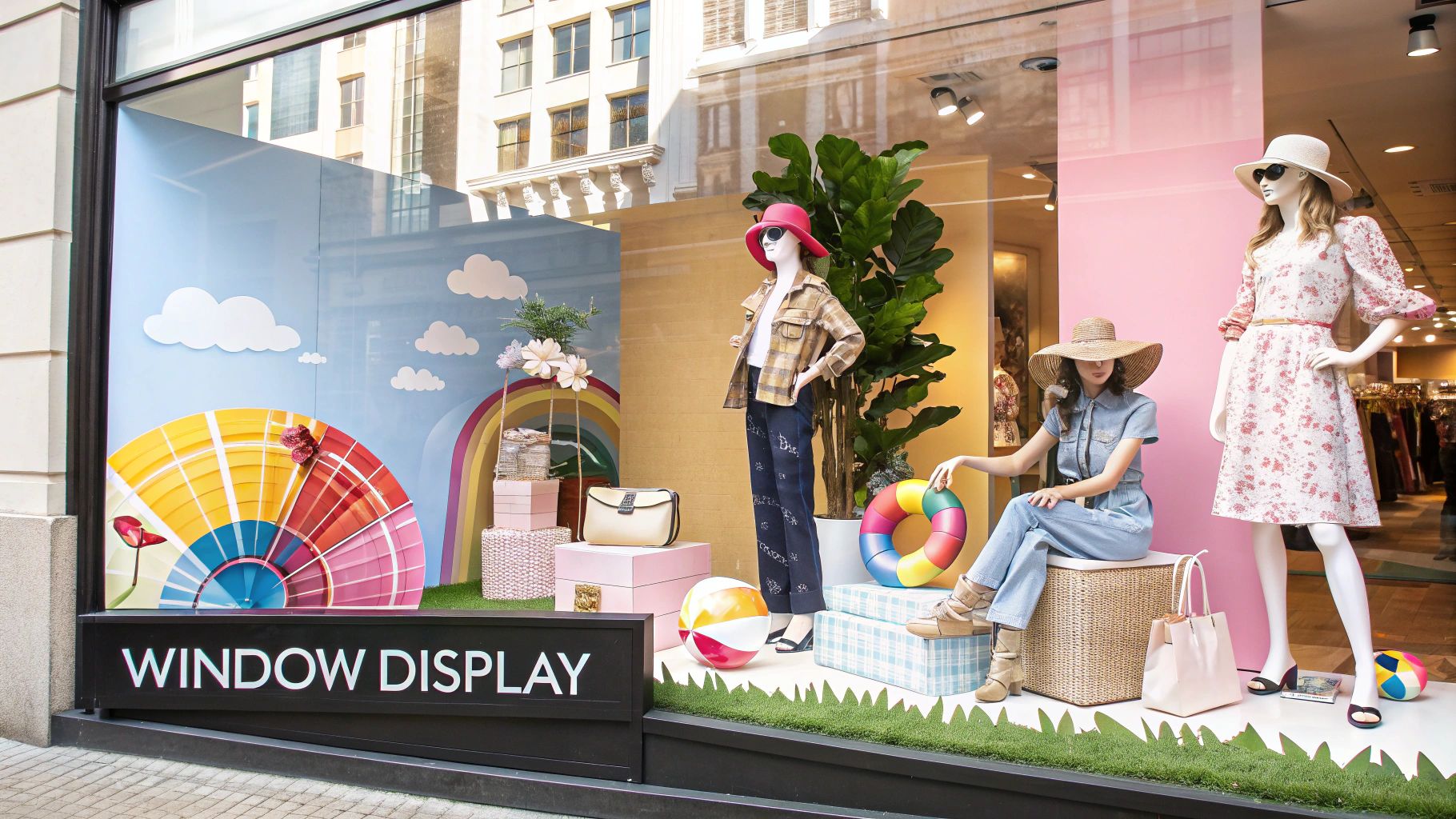
This strategic thinking is especially important right now. The UK retail sector's economic outlook for 2025 is cautiously optimistic, showing signs of growing consumer spending. Statistics consistently show that well-executed visual merchandising drives impulse buys and strengthens customer loyalty, making it a crucial tool for capturing this renewed spending power. This means that smart, targeted investments in your displays can deliver significant returns. You can explore detailed forecasts on the UK retail industry for a deeper analysis.
Prioritising for Maximum Return
When resources are tight, you have to focus on what delivers the biggest bang for your buck. Begin by identifying your "hero" products—the items that are either your bestsellers or carry the highest profit margins. This is where you should concentrate your visual merchandising efforts. You don’t need expensive custom fixtures to make them stand out. Instead, prioritise these key areas:
- Lighting: This is your most powerful tool. A single, well-aimed spotlight can turn a standard product into a must-have item. Investing in adjustable track lighting is a versatile, long-term solution that costs much less than a full store renovation.
- Signage: Clear, professional, and on-brand signage is essential. It guides customers, tells product stories, and communicates value. Avoid handwritten signs at all costs; they cheapen the perception of your products.
- Props and Height: Create visual interest by using affordable props like painted wooden crates, books, or simple risers to vary the height of your displays. This simple technique breaks up visual monotony and draws the eye.
Smart Investments and Creative Solutions
A few thoughtful purchases can elevate your entire store. A high-quality mannequin with a stand is a fantastic investment, as it lets you showcase complete outfits and tell a compelling product story. You can check out our complete guide on using a mannequin with a stand for display success to learn more.
For retailers on tighter budgets, creativity is your greatest asset. Upcycling old furniture, using natural elements like branches, or creating bold backdrops with a simple pot of paint can create a premium feel without the premium price tag. Ultimately, resourcefulness often leads to more authentic and memorable displays than a limitless budget ever could.
Your Implementation Roadmap For Better Sales Results
Knowing the principles of visual merchandising is one thing, but applying them is what really makes a difference. To truly transform your retail space, you need a clear, prioritised plan. This roadmap breaks the process into practical steps, focusing on quick wins you can implement now and longer-term strategies for steady growth. Following these visual merchandising guidelines will help you build a more inviting customer experience and directly impact your sales figures.
Your Action Plan: From Quick Wins to Long-Term Strategy
It's best to start with small, high-impact changes before moving on to larger projects. This approach helps you build momentum and see results fast without feeling overwhelmed.
Phase 1: Immediate Improvements (This Week)
- Declutter and Clean: This is the easiest and most powerful first step. Take down any old or unnecessary signs, make sure pathways are clear, and give every surface a thorough clean. A tidy, organised space instantly looks more appealing and professional.
- Focus on a Hero Display: Pick one of your best-selling or high-margin products and create a standout display for it. Use the Rule of Three, add a spotlight, and tell a simple story with the arrangement.
- Check Your Entrance: Your decompression zone should feel open and welcoming. Place your most exciting new products on a display just to the right of the entrance to grab shoppers' attention as soon as they walk in.
Phase 2: Foundational Changes (This Month)
- Audit Your Lighting: Walk through your shop and spot any poorly lit areas. Investing in affordable spotlights or track lighting can highlight key product zones and get rid of gloomy corners.
- Create Clear Signage: Design and print professional signage that matches your brand. Make sure prices are easy to read and that any special offers are simple to understand.
- Review Customer Flow: Spend some time watching how people navigate your shop. Are there any tight spots or dead zones they avoid? Try making small adjustments to your fixtures to guide them on a smoother journey.
The image below shows a great example of a clothing display, a central part of effective visual merchandising. This display uses grouping, layering, and focal points to show a complete look, which encourages customers to buy multiple items. For clothing retailers, showing sizes and fits clearly is essential; you might find our guide on how to take body measurements for clothes helpful.
Measuring Success and Making Adjustments
Applying these guidelines isn't a one-off job; it's a continuous process of testing and improving. To figure out what's working, you need to track the right metrics. Keep an eye on sales data for products in your new displays, notice how long customers spend in different areas, and don't hesitate to ask for direct feedback. If a display isn't performing well, be ready to change it. This data-focused approach ensures your efforts are always aimed at what most affects your bottom line.
Ready to bring your visual merchandising ideas to life? At Display Guru, we offer the high-quality mannequins, body forms, and garment rails that are the foundation of great retail displays. Explore our collection at https://www.displayguru.co.uk and find the right tools to turn your vision into sales.
